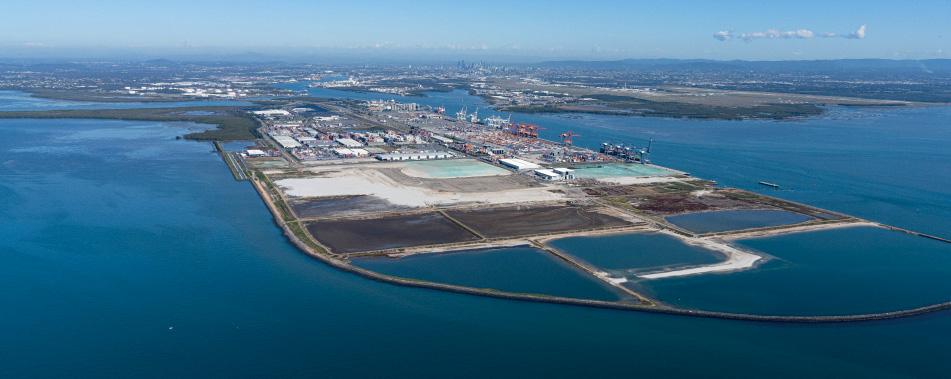
7 minute read
Cruise
MAKING BRISBANE FUTURE-READY
A new green cruise terminal development at the Port of Brisbane is confi rming the port’s emerging identity as a signifi cant player in the Australian cruise market, writes Michele Witthaus
Identifying a long-term, sustainable solution to supporting and growing Brisbane’s cruise tourism industry is at the heart of the Brisbane International Cruise Terminal (BICT) development, says Neil Stephens, chief executive offi cer, Port of Brisbane Pty Ltd (PBPL).
He believes that, with the resumption of cruising now given the green light by the Australian and Queensland governments from June, the BICT is primed to be the epicentre of Australia’s cruise recovery story.
“The BICT was developed out of a pressing need identified by the cruise industry to ensure that Brisbane, Queensland’s capital, had a terminal able to accommodate the mega cruise ships (longer than 270 metres) that were seeking to call in the city,” he says. “Brisbane faced a challenge in that mega cruise ships had to call at the Port of Brisbane’s cargo port and could not access the existing cruise facility further upstream.”
Long-term solution
As the global cruise vessel fleet continued to increase in size, Brisbane risked being bypassed if it did not have a long-term solution to welcoming larger vessels.
Working with government and cruise industry stakeholders, including government and the cruise industry, Port of Brisbane Pty Ltd (PBPL) identified the most suitable site in Brisbane that could accommodate these larger vessels, at the mouth of the Brisbane River at Pinkenba.
“From an economic and social perspective, our focus was on working with the cruise industry and government to design and deliver a facility that would support the cruise tourism industry now and help it to grow in the future.
“By ensuring the terminal can accommodate the largest ocean-going vessels, that means the cruise industry will continue to call in Brisbane and bring with it the economic and tourism benefits that will support local jobs and related industries. We also have a formal partnership with local government to promote Brisbane tourism at the cruise terminal and have continued to liaise with the local residential community throughout the construction process.”
Green design
From an environmental perspective, the BICT building incorporated sustainable design principles (developed collaboratively with PBPL’s lead designer Arup and architect Arkhefield) that embrace Brisbane’s subtropical climate and lifestyle and deliver positive sustainability outcomes.
“Sustainability was considered well before construction, starting with the condition of the site itself,” says Mr Stephens. “The cruise facility was developed on degraded greenfield land, so early challenges included increasing the resilience of the site to sea level rise and flooding, due to its geographic location on the Brisbane River.”
This careful planning paid dividends during the severe February/March 2022 flooding in Brisbane, with no impact to the terminal building or site despite the Brisbane River rises.
Brisbane’s subtropical climate was also a key factor that would impact a range of things including the building’s design, material consumption, current and future energy use and, importantly, passenger comfort.
“In terms of the building’s design, significant consideration was given to the building’s orientation, natural lighting and sun shading to maximise natural light and improve the user experience while reducing reliance on alternative energy sources and associated pollution,” says Mr Stephens.

Credit: Port of Brisbane Pty Ltd (PBPL)
Credit: Port of Brisbane Pty Ltd (PBPL) 8 An aerial view of
the Port of Brisbane
8 Plaza area at
the Brisbane International Cruise Terminal

Credit: Port of Brisbane Pty Ltd (PBPL)
“This was further supported by elements including natural ventilation used where possible, sub-tropical landscaping, water-sensitive design and living greenery to provide shade, cool public spaces and reduce the ‘heat island’ effect of the terminal area. We achieved a reduction in ongoing water use through rainwater harvesting providing water for amenities.”
The building design and location also supports potential future expansion of both wharf and terminal facilities if it is required.
Greenfi eld site
The new site had to be able to access existing marine infrastructure such as naturally occurring deep water, a swing basin and navigation channels. This aspect of planning removed the need for capital dredging and minimised impact on the surrounding natural environment.
The greenfield site required significant fill and surcharging before construction could commence. Approximately 300,000 cubic metres was placed across the site throughout this stage of works. PBPL was in a unique position to re-use dredge material from its existing dredging operations as fill, elevating the site to achieve appropriate levels and creating a stable base for the development. “For surcharging, we were able to utilise our dredge vessel, TSHD Brisbane, to place clean sand from existing channel maintenance dredging on the site,” says Mr Stephens.
The surcharge was removed and re-used on other PBPL development projects. A substantial amount of consideration was also given to energy use and capabilities – both now and into the future.
“The building maximises natural ventilation, has energy- and water-efficient appliances and fittings, and will utilise solar energy as its main power source when the building is fully operational.”
An 800kW rooftop solar system provides shaded car parking for passengers, while generating approximately 1300MWh power annually and reducing the energy draw from the grid. Electric vehicle charging stations are also available for the public to use.
Future energy integration has been incorporated into the base design, to enable future installation of additional solar panels and battery storage. “Alternate fuel types were considered during the design phase,” says Mr Stephens. “The facility has been designed to enable future capability for LNG bunkering if and when a suitable supply is available in Australia and there is a demand from an LNG-capable vessel.”
Better connected
In terms of its location, the BICT is ideally located only 15 minutes from Brisbane Airport with local roads providing easy access. It is also located only 15 minutes to major motorway (north-south) and arterial roads (into the CBD and suburbs). As it is located on the river, there are potential future opportunities for river connectivity. Mr Stephens says there will be continued engagement with government regarding future connectivity opportunities by river as well as other transport connections.
Geographically, the BICT is located away from the main cargo port, which is on the opposite side of the Brisbane River. Before the BICT’s construction, cruise ships that called at the Port of Brisbane had to share the grain berth with agricultural customers. As a dedicated facility for cruise, the new terminal has freed up capacity at the Port’s agricultural berth and ensures there is no compromise in the design and use of the BICT with other cargo types.
“One of the major benefits that PBPL is exploring is the addition of the BICT’s 800kW solar to our existing solar system network on PBPL-managed buildings,” says Mr Stephens. “As the largest solar installation by PBPL to date, this system produces a significant amount of renewable energy which we are currently distributing to other PBPLoperated sites through a virtual energy network.” This in turn will reduce reliance on grid energy and subsequently help cut Scope 2 carbon emissions.
Significant focus was put into ensuring the facility would enable safe and efficient operations during its lifetime. “As the asset manager, our primary role is to provide a facility that meets the needs of the cruise industry both now and well into the future,” says Mr Stephens. “A key part of this was understanding how to optimise passenger and cargo flows, as well as building flexibility into the facility to enable it to adapt to future changes in the industry. This should position the terminal well to grow with the local cruise tourism industry for decades to come.”
The potential benefits of the BICT on growing Queensland’s cruise industry are significant, he says. “Importantly and as a first step, we believe the BICT is primed to be the epicentre of Australia’s cruise recovery story.
“Looking ahead over 20 years post-Covid, the BICT has the potential to triple Brisbane’s cruise industry to support 3750 jobs, bring over 760,000 visitors annually and contribute $1.3 billion in net expenditure to the Brisbane economy. This will support the cruise tourism industry not just in Brisbane but throughout South East Queensland and Queensland more broadly.”
PBPL also has a formal partnership with the local government to promote regional tourism and is exploring opportunities to support Indigenous cultural tourism and regional economic and education activities. story. rs post-Covid, the BICT has the cruise industry to support 3750 rs annually and contribute $1.3 to the Brisbane the cruise tourism e but throughout Queensland more rtnership with the regional tourism to support m and ation

8 A greenfi eld
site was carefully chosen for construction of the Brisbane International Cruise Terminal
8 Neil Stephens,
chief executive offi cer, Port of Brisbane Pty Ltd (PBPL)








